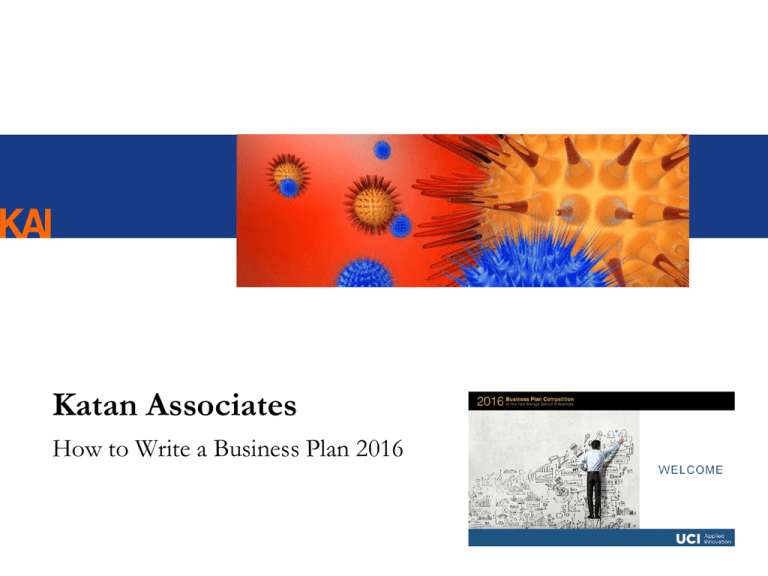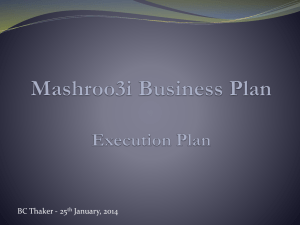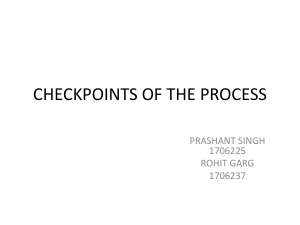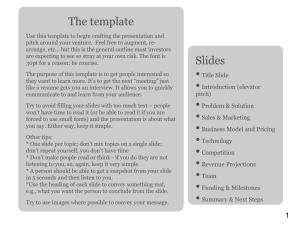
Katan Associates
How to Write a Business Plan 2016
Disclaimer
•
MY OPINION
2
Our Services
• Strategic Consulting
–
–
–
–
–
–
Market assessment and competitive analysis
Product and corporate positioning
Technical due diligence
Corporate planning
Start up and spin out of technologies
In licensing technologies to facilitate strategy or company formation
• Partnering / Non-Dilutive Financing
• Mergers and Acquisitions
• Technical Due Diligence
• Management Coaching
• Government and Industry Advisory
3
Founder
•
Seth Yakatan, Founder
– Twenty years experience in venture capital,
merchant banking and corporate
development
– Eight year direct investing experience as a
Principal at UBOC
– Three years of direct investment
experience in Venture Capital
– Advisor to state government of Victoria,
Australia
– Closed over $800M in partnering and
M&A deals for clients since 2001
– Founder of 8 life sciences companies
– Faculty member for BIO annual Executive
Workshop Series
– MBA in Finance from the University of
California, Irvine
4
Our Team – Associates and Partners
North America
Marvin Collin
Steven Olasky
Dan Zemel
Mike Weiner
China
Europe
Roman Rittweger
Peter Kalinka, PhD
Jean-Luc Centeleghe, PhD
Kyle Yang
India
Dinesh Jain
Japan
Tsutomu Mori
Biocomm2
Israel
Alf Fischbein, MD
Brazil
Taiwan
Fundaçäo Biominas
Eduardo Soares
Hun Chi Lin, PhD
ITRI
Australia
Andy Gearing, PhD
Biocomm2
5
Representative Clients
6
Agenda
•
•
•
•
•
•
Risk & Milestones
How I Do It
Business Plan 101
Specific Criteria
A Few More Tips
Q&A
7
Case #1:
Merchant Banking/M&A/Financing
•
Facilitated the merger of Isatori, Inc. (OTCBB:IFIT) and Fit Life Brands, Inc.
(OCTQB:FTLF) to create a significant player in the nutritional supplement sector
•
Took on role as Interim-CFO of iSatori, Inc.in April 2015
•
Announced completion of merger documentation May 2015
•
Subsequent regulatory and shareholder approval was gained in September 2015
•
Current company is listed with in excess of $30.0 million in revenue and trades under the
symbol OTCBB: FTLF.
•
Katan will serve on the board of the combined entity going forward.
•
Katan identified the merger candidate, facilitated the merger, assisted in the
subsequent financings and has helped to manage the company since 2014
8
Case #2
Advaxis, Ltd.
•
•
•
•
•
•
•
Assisted in the repositioning and up-listing of Advaxis, Inc.
Facilitated bridge loan
Executed on Asian partnership
Advaxis then raised in excess of $27.0 million
Advaxis, Inc. (ADXS) is now a clinical-stage life sciences company targeting
immunotherapies based on a technology platform which uses engineered Listeria
monocytogenes
Advaxis has 2 FDA-regulated phase II clinical trials currently underway
Current entity has in excess of a $600.0MM market capitalization
9
Case #3
Nexvet Biopharma
•
•
•
•
•
•
•
•
•
Assisted in the formation of the company
Nexvet is a leading veterinary biologic drug developer
Utilized R&D tax credits and grant funding to facilitate growth of the company
Assisted in the raise of a $7.0 million seed round
Facilitated drug specific partnership in Japan
In April 2014 Nexvet raised in excess of $31.0 million from a group of US
institutional investors
The company currently has three products in clinical development
In February 2015, Nexvet (NVET), went public on NASDAQ and raised in excess
of $36.0 million from a group of US institutional investors
The company has a current market capitalization in excess of $60.0 million
10
Case #4:
Merchant Banking/M&A/Financing
•
Facilitated the merger of C-Bio, Ltd. and Inverseon. Inc. to create Invion, Ltd.
(ASX:IVX)
•
Took small molecule therapeutics company in the USA and merged with ASX listed
public company with $12.0 million in cash as a form of financing
•
Subsequent to the merger have raised in excess of $15.0 million
•
Invion Limited (ASX:IVX) is now a clinical-stage life sciences company targeting chronic
inflammation with 3 drug candidates in development
•
Invion has 3 FDA-regulated phase II clinical trials currently underway
•
Current entity has in excess of a $50.0MM market capitalization
•
Katan identified the merger candidate, facilitated the merger, assisted in the
subsequent financings and has helped to manage the company since 2012
11
What Makes
Katan Unique?
Simply a parabola...opening UP
13
Most of Our Companies/Projects
Are Considered Development Stage
• All of the therapeutic partnerships we have completed are Phase IIb or earlier
– Majority have been at IND or pre IND stage
• We have gained an international reputation amongst Universities, Research
Institutions, Government Agencies, and Government Policy Makers for being able
to find commercialization and development partners for projects
• Several of the companies that we have formed have been the result of a pro-active
search for specific technology or specific intellectual property
14
We Have Strong Deal Flow
• For the past nine years we have logged an average of 485 distinct transaction
opportunities from across the globe
– Many of these are from non-G8 countries
– Many of these come from the Outreach 5 countries
• We do little to no outbound marketing to attract this deal flow as 90% of our
business is referral-based
• Experience and knowledge to determine commercial opportunities related to early
stage technology
15
Our Network is Global
• Our model has been to partner with a local service provider or company on a joint
venture basis, this allows for:
–
–
–
–
–
–
–
Unique knowledge of the local culture and customs
Access to local, state and federal governments
Access to local, state and federal agencies and institutions
Access to local, state and federal universities
Access to native funding networks and investors
Access to native service providers
A regional physical presence and local office
16
Risk & Milestones
Milestones ???
18
Risk
Commercialization
Most new technologies go through a long maturity-this
can take up to 20 years development cycle before
they reach commercialization
”Debugging”
”Early
Hype”
Value
Risk
”Dissapointments
and disillusion”
Time
19
Milestones of Development
IP Creation
Invention:
Functional
Basic Research
Proof of
Concept
NSF, NIH
Corporate Research
SBIR Phase I
Angels
Corporations
Technology Labs
SBIR Phase II
Business
Validation
New Firm
or Program
Viable
Business
Early-Stage
Technology
Development
Product
Development
Production /
Marketing
VC
Equity
Debt
Capital Markets
Taken from “Between Invention and Innovation An Analysis of Funding for Early-Stage Technology Development”
Prepared for NIST Economic Assessment Office November 2002, page 33
20
An Example…
Milestone 1 Timeline
Milestone 2 Timeline
Selection of First Drug/Implant Selection for PK Studies
Insero Short-Term Milestones
Use of Funds
Q1
2009
Q2
2009
Milestone 1
Selection of First Drug/Implant Candidate for PK
Indapamide Feasibility Study
100,001
Enalapril Feasibility Study
99,999
Finalize license from Indevus
Selection of 1st Drug/Implant Candiadte
99,999
100,001
Q3
2009
Q4
2009
Q1
2010
Preparation of IND for First Drug/Implant Combination
Q2
2010
Q3
2010
Total
Insero Short-Term Milestones
Use of Funds
200,000
200,000
250,000
Insero G&A Burn
52,000
46,000
52,000
0
0
0
0
150,000
Total
252,000
246,000
302,000
0
0
0
0
800,000
Cash-Post Series A
Investment of $1,750,000
1,498,000
1,252,000
Milestone 2
Preparation of IND for 1st Drug/Impant Combination
Retain regulatory consultant
Meet with Ethics Advisors
Optimization Studies
PK Study
Statistical Analysis
Complete Pre-IND Meeting with FDA/TGA
Preparation of IND for 1st Drug/Implant
200,000
200,000
250,000
250,000
Q1
2009
650,000
Q2
2009
Q3
2009
Q4
2009
Q1
2010
Q2
2010
6,000
9,000
12,500
37,500
39,267
9,000
37,500
9,000
117,800
12,500
78,533
50,000
37,500
37,500
Q3
2010
Total
33,000
50,000
75,000
235,600
50,000
50,000
Milestone 2 Cash
43,500
98,267
176,800
175,033
Insero G&A Burn
0
59,500
57,000
57,000
57,000
493,600
230,500
Total
43,500
157,767
233,800
232,033
57,000
724,100
Cash-Post Series A
Investment of $1,750,000
906,500
748,733
514,933
282,900
225,900
950,000
Copyright © 2007. All Rights Reserved. Confidential Property of GenXL LLC.
Copyright © 2007. All Rights Reserved. Confidential Property of GenXL LLC.
Milestone 3 Timeline
IND Filing for First Drug/Implant Combination
Insero Short-Term Milestones
Use of Funds
Q1
2009
Q2
2009
Q3
2009
Q4
2009
Q1
2010
Q2
2010
0
0
0
0
0
0
Q3
2010
Total
75,000
75,000
75,000
75,000
Milestone 3
IND Filing
IND Submission
IND Granted
Milestone 3 Cash
Cash-Post Series A
Investment of $1,750,000
150,900
21
Copyright © 2007. All Rights Reserved. Confidential Property of GenXL LLC.
An Example…
Milestone 1 Timeline
Selection of First Drug/Implant Selection for PK Studies
Insero Short-Term Milestones
Use of Funds
Q1
2009
Q2
2009
Milestone 1
Selection of First Drug/Implant Candidate for PK
Indapamide Feasibility Study
100,001
Enalapril Feasibility Study
99,999
Finalize license from Indevus
Selection of 1st Drug/Implant Candiadte
99,999
100,001
200,000
Insero G&A Burn
Q3
2009
Q4
2009
Q1
2010
Q2
2010
Q3
2010
Total
250,000
200,000
200,000
250,000
200,000
250,000
650,000
52,000
46,000
52,000
0
0
0
0
150,000
Total
252,000
246,000
302,000
0
0
0
0
800,000
Cash-Post Series A
Investment of $1,750,000
1,498,000
1,252,000
950,000
Copyright © 2007. All Rights Reserved. Confidential Property of GenXL LLC.
22
An Example…
Milestone 2 Timeline
Preparation of IND for First Drug/Implant Combination
Insero Short-Term Milestones
Use of Funds
Q1
2009
Milestone 2
Preparation of IND for 1st Drug/Impant Combination
Retain regulatory consultant
Meet with Ethics Advisors
Optimization Studies
PK Study
Statistical Analysis
Complete Pre-IND Meeting with FDA/TGA
Preparation of IND for 1st Drug/Implant
Q2
2009
Q3
2009
Q4
2009
Q1
2010
Q2
2010
6,000
9,000
12,500
37,500
39,267
9,000
37,500
9,000
117,800
12,500
78,533
50,000
37,500
33,000
50,000
75,000
235,600
50,000
50,000
493,600
37,500
Q3
2010
Total
Milestone 2 Cash
43,500
98,267
176,800
175,033
Insero G&A Burn
0
59,500
57,000
57,000
57,000
230,500
Total
43,500
157,767
233,800
232,033
57,000
724,100
Cash-Post Series A
Investment of $1,750,000
906,500
748,733
514,933
282,900
225,900
Copyright © 2007. All Rights Reserved. Confidential Property of GenXL LLC.
23
An Example…
Milestone 3 Timeline
IND Filing for First Drug/Implant Combination
Insero Short-Term Milestones
Use of Funds
Q1
2009
Q2
2009
Q3
2009
Q4
2009
Q1
2010
Q2
2010
Q3
2010
Total
75,000
75,000
75,000
75,000
Milestone 3
IND Filing
IND Submission
IND Granted
Milestone 3 Cash
Cash-Post Series A
Investment of $1,750,000
0
0
0
0
0
0
150,900
Copyright © 2007. All Rights Reserved. Confidential Property of GenXL LLC.
24
Why are Milestones Important?
• Achievement of them de-risks
projects
• Lower risk, higher value
25
Are you ready to start today ?
•
•
•
•
•
•
•
What do you have?
Why is it novel?
What is the market?
At what stage of development is it?
Can one technology support the formation of an entire company?
Who can help ?
Where do I get $$$$$$$ ?
26
DP’s Issues
• Inability to tell the story properly
• Failure to meet or respect the time frame
• Failure to explain the value proposition
• Failure to disclose issues up-front
• Lack of knowledge of the competitive landscape
27
It IS a Tough Road
• There is a high failure rate in new ventures
– Approximately 20% are successful in obtaining more than 1 round of
capital
• VC’s strive for failure rates of 80% on investments
– 5 in 10 investments fail
– 3 in 10 investments breakeven
– 2 in 10 investments succeed
• A 2012 report by PriceWaterhouseCoopers indicates that only
10% to 15% of venture capital funds produce profit-generating
firms
28
Would You Have Invested?
29
How Do I Do It?
Our Criteria – K. I. S. S.
• Do we believe that the people involved can get the
job done?
• Does the product/technology/company have a
sustainable competitive advantage?
• Do we share similar expectations of value and
outcomes?
• Can we add value to the company/process given
our involvement?
31
4 Easy Steps
•
•
•
•
Elevator Pitch
Presentation
Executive Summary
Plan
–
–
–
–
–
–
–
Executive Summary
Products or Services
Market Need (Marketing ??)
Market Potential
Competitive Advantage
Management
Financial Overview
32
The Elevator Pitch
• Do we know what this is ???
• An elevator pitch (or elevator speech) is a brief overview of an idea for a
product, service, or project.
• The pitch is so called because it can be delivered in the time span of an
elevator ride (say, thirty seconds or 100-150 words).
• Part Mission Statement
• Part Positioning Statement
33
Presentation
• Use as a high level outline for the business plan
–
–
–
–
–
–
–
Executive Summary
Products or Services
Market Need
Market Potential
Competitive Advantage
Management
Financial Overview
34
Executive Summary
•
•
•
•
•
•
•
•
Most important piece of the Plan
Begin with the Elevator Pitch
Talk about product / service
Highlight Market
Promote Management
Use of Proceeds
Ask for the $$$
What is the value ?
35
Business Plan
•
•
•
•
•
•
•
Executive Summary
Products or Services
Market Need
Market Potential
Competitive Advantage
Management
Financial Overview
36
B-Plan 101
©2012. All Rights Reserved. Katan Associates.
What is a Business Plan ??
• A business plan is any plan that works for a business to look ahead,
allocate resources, focus on key points, and prepare for problems and
opportunities
• Plans don't sell new business ideas to investors. People do. Investors
invest in people, not ideas. The plan, though necessary, is only a way to
present information
38
Purpose
• Business planning is about results
• You need to make the contents of your plan match your purpose
• Don't accept a standard outline just because it's there
39
Key Factors
•
•
•
•
•
Simplicity
Believability
Focus
Management
Milestones
40
Key Mistakes
•
•
•
•
•
•
•
Management
Competition
Idea / Technology inflation
Belief in the market
Valuation or Lack of Valuation
Answering questions
Lack of milestones
41
ABRAHAM LINCOLN
•
•
•
•
•
•
•
•
•
•
•
1831
1832
1834
1835
1836
1843
1848
1855
1856
1859
1860
Failed in Business
Lost bid for Illinois State Legislature
Failed in Business
Fiancé died
Suffered a nervous breakdown
Ran for Congress and Lost
Tried again for Congress and Lost
Ran for US Senate and Lost
Tried for Vice President and Lost
Lost bid for Senate again
Became 16th President of the US
42
Specific Criteria
Business Plan
Katan’s Concepts
•
Executive Summary
•
Products or Services
•
Market Need
•
Market Potential
•
Competitive Advantage
•
Management
•
Financial Overview
•
Development pathway
•
IP
•
Technology overview
•
BOD
•
AB
Competition Requirements
•
Executive Summary
•
Products or Services
•
Market Need
•
Market Potential
•
Competitive Advantage
•
Management
•
Financials
44
Some things to consider…
•
•
•
•
•
•
•
•
•
•
•
Does the plan explore an opportunity that is realistic?
Is the business model well thought out and have the potential to be effective?
Are there past benchmarks set that the plan can be measured against?
Is a significant initial investment required?
What is the length of the implementation process?
Does the business have the necessary tools to become a market leader?
Has a clear target customer been established?
Does the management team have the skills to succeed?
What are the projections for the venture to achieve profitability?
Is the plan concise and well written?
What will allow this business plan to have sustained success?
45
Executive Summary
•
•
•
•
•
•
•
What problem are you solving?
What is your business proposition for solving the problem?
Who are your customers?
Who are your competitors?
How viable is your business?
How do you make money?
Executive Summary is clear & effective as a stand-alone document
46
Products or Services – What ?
•
•
•
•
What is the product or service?
What are its attributes?
Advantages and potential drawbacks?
Why/how is your product/service more compelling than existing ones or
the competition? What is the stage of development?
• Do you have a proprietary position or intellectual property protection
planned or in place?)
47
Market Need – Why ?
• What specific conditions in the market have created the problem you are
solving?
• How will your product/service take advantage of the opportunity?
• Who are your customers and what are their attributes?
• Clearly define your potential customers and why they will pay for your
product or service
48
Market Potential – Why ??
•
•
•
•
•
•
What are the characteristics of the market for your product or service?
How will you reach the market?
How big is the market opportunity: number of potential customers & annual
sales?
Can you narrow the market to a manageable segment?
How will you dominate the market? e.g. through pricing, quality, geography, etc?
Is there a market niche where you will have competitive advantage?
49
Competitive Advantage – How ?
•
•
•
•
•
Competitive Matrix: Who are your competitors?
Their strengths & weaknesses?
Your strengths & weaknesses?
How will you close the gap?
How easily can competition close gap?
50
Management – Who ?
• Who are key team members and their respective roles?
• What are their relevant experiences and accomplishments?
• What other areas of expertise are you lacking?
• When will you need additional team members?
51
Financials
•
•
•
•
•
Income Statement
Balance Sheet
Funds Required & Uses
Key Assumptions
Financial Model
52
A Few More Tips….
I’m NOT That Smart…
54
REALLY I’m NOT…
55
Even Better Let Them Do the Work
56
Clayton Christensen:
Disruptive Technologies
•
The term disruptive technology was coined by Clayton M. Christensen and described in his 1997 book The Innovator's
Dilemma.
Disruptive Technologies
Displaced
steam engines and internal-combustion engines
horses and humans (for powering machines)
Hydraulic excavators
Cable-operated excavators
mini steel mills
vertically integrated Steel mills
minicomputers
mainframes
Container ships and containerization
"Break cargo" ships and stevedores
desktop publishing
traditional publishing
digital photography
originally, instant photography, now increasingly all chemical
photography
personal computers
minicomputers, workstations
57
Clayton Christensen:
Disruptive Technologies
•
Main Principals
– 1. Companies listen to their customers, and strive to bring to the market the products their
customers ask for.
– 2. Small Markets Don’t Solve the Growth Needs of Large Companies.
– 3. Markets that don’t exist can’t be analyzed: Get close to your customers, learn their needs.
– 4. Technology Supply May Not Equal Market demand.
58
Valuation
„Trying to assess basic research by its
practicality is like trying to judge Mozart
by how much money the Salzburg
Festival brings in each year.“
Konrad Lorenz
59
Valuation
“Of the 300-odd public companies
in the biotechnology business,
8 have meaningful earnings from
selling products. The rest trade on
the strength (or weakness)
of their ideas. ”
M. Gianturco in Forbes
60
Definitions
Pre Money Valuation = notional amount of equity value prior to any equity investments
Pre Money Valuation + Invested Capital = Post Money Valuation
Price per share = Pre Money Valuation / Pre-Money Shares
+ $5 million =
$5 million
pre-money
$10 million
post money &
50% ownership
Taken from “Understanding Valuation: a venture Investor’s perspective”
Callow, etal, Boston Millenia Partners White Paper
61
Series A Valuations - Revealed
•
Series A valuations are usually based on percentages - as in, how much of the
company does the venture capital fund want to own
•
Most established venture funds have an established strategy of owning a
particular percentage of a company after a Series A investment
•
A typical, good fund will look to own 20% to 33% of a company after the initial
investment
•
During a normal two-VC, syndicated Series A investment the startup sells around
half the company to the VC
•
•
Raising $4 million? Pre-money of $4 million
Raising $6 million? Pre-money of $6 million
62
Summary
Type of
valuation
Equity
multiples
(PE)
What it gives
you
Why people
use it
Common
equity
value only
Easy to
calculate
and understand
Enterprise
multiples
(Sales,
EBIT,
EBITDA)
Firm value
which can be
split into equity
value after
deducting net
debt
Avoids
distortions due
to accounting
policies (D&A
etc)
Tech.
value
DCF
Leveraged
value
Value of
products or
platform over
and above cash
Fundamental
value of a
company based
on cash flows
How much
debt a
company can
support
How much a
company can
be acquired for
and possible
routes of
finance
Easy to
calculate
and understand
Dependent on
business plan
not distorted by
market
sentiment
To estimate
how much a
financial buyer
can pay
Assesses
impact on
shareholders
However, life science companies are often loss making and not forecast to be profitable
over a 2-4 year time horizon
63
Valuation – football field example
Valuation overview
Valuation range
Enterprise value (US$ m)
70
Trading multiples
FV/sales 04
1.0x
80
90
110
120
130
140
150
1.4x
10.0x
FV/EBIT 04
100
13.0x
DCF (Implied FV/EBIT 04 multiple)
19.4x
13.5x
Precedent transactions
1.2x
1.6x
FV/sales 04
11.0x
FV/EBIT 04
14.0x
Implied multiples
US$ m
Implied multiples
FV/sales
2004E
2005E
71.2
73.7
1.0x
0.9x
1.1x
1.1x
1.3x
1.2x
1.4x
1.4x
1.5x
1.5x
1.7x
1.6x
1.8x
1.8x
2.0x
1.9x
2.1x
2.0x
FV/EBIT
2004E
2005E
7.3
10.1
9.6x
6.9x
11.0x
7.9x
12.3x
8.9x
13.7x
9.9x
15.1x
10.9x
16.4x
11.9x
17.8x
12.9x
19.2x
13.9x
20.5x
14.9x
FV/EBIT
+restr. costs
2004E
9.0
7.8x
8.9x
10.0x
11.1x
12.2x
13.3x
14.4x
15.6x
16.7x
This leads to a core valuation range
64
Sirtris Pharmaceuticals
•
•
Founded in 2004 in Cambridge, MA
Technology licensed from Harvard University in August 2004
–
•
Sirtuins and Resveratrol (natural substance found in red wine)
–
–
–
•
Family of enzymes which regulate the aging process
Activates SIRT1 and confers certain beneficial effects of calorie restriction without requiring a
reduction in normal calorie intake
Major articles published in Cell and Nature in 2006
Funded by Polaris, TVM, Skyline, CHP, Three Arch, GSK, Novartis
–
–
•
•
$100K upfront, $1.6 million in milestones
Raised $172 million ($103 million in VC, $69.0 million at IPO)
VC Partner from Polaris became CEO
IPO in 2007
Acquired by GSK in 2008 for $720.0 million
65
Sirtris Financing History
66
Data
Financing
Company Stage
Data
Risk /
Uncertainty
Value in
Millions
Seed
Incorporation / early
Development
Soft / Value
Proposition
Extremely High
$1+
Series A (First Inst
Round)
Development
Validation / Time to
Market
Very High
$3+
Series B
Shipping product
Prelim Revenue
High
$7.5+
Series C
Shipping product
Predict Revenue
Moderate
$10+
Mezz /Later
Shipping product /
Profitable
Hard Data, EBITDA,
Net Income
Low
$20 to $50+
Taken from “Understanding Valuation: a venture Investor’s perspective”
Callow, etal, Boston Millenia Partners White Paper
67
The Exit
•
•
•
•
It there one ?
How realistic is it ?
What happens if there is none ?
Is that okay ?
68
Key Lessons for Success
•
•
•
•
•
•
•
Products must have large and near-term markets
Compatible corporate team
Level of funding sufficient to meet goals
Observant – follow market – don’t discard anything
Confidence in common sense
Be prepared for competition – new product pipeline
Need luck and smart friends
69
Q&A






